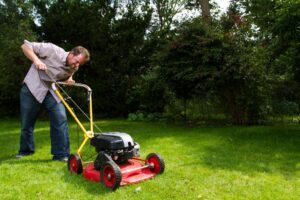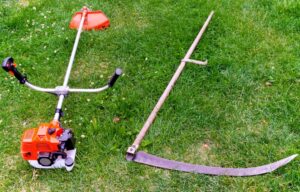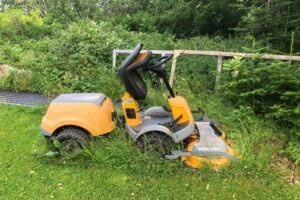While many species of plants may need more than one season to develop after germinating fully, some plant types are much slower growing. In general, two main factors affect recovery from dormancy: temperature and moisture conditions.
Table of Contents
ToggleWhat is Grass Dormancy?
Dormancy occurs when seeds stop growing and don’t produce new stems because they have no energy left to do so. This happens during cold and dry periods when temperatures get too low or soil becomes a poor water source.
It also happens naturally as part of the life cycle of certain plants. For example, trees take three years to grow into an adult tree and usually only sprout leaves during the warm seasons.
The same concept applies to grasses. When spring arrives, and the soil warms up, the seedling inside the tiny root system starts to push its way through the dirt. If the soil isn’t hospitable enough or there isn’t enough rainwater, the grass won’t emerge. Or, even worse, it could die.
How Long Does it Take for Dormant Grass to Recover?
Dormant grasses will return to normal after the soil warms up and the sun shines again. Some grasses can recover faster than others, depending on where they live. In Georgia, for example, most people see greening starting within a week after rainfall. Other states, however, like New Mexico, Texas, and Arizona, tend to experience more extended periods of drought before any greenery emerges.
For those areas, it typically takes anywhere from six months to a year before grasses start to green up. And the further north you move toward Canada, the longer it takes to recover from dormancy.
However, this doesn’t mean all grasses are created equal. There are different varieties of grasses, and each type responds differently to the environment. Some grasses, for instance, can tolerate wetter soils better than others. So if your grass goes dormant at the wrong time, you could end up losing it forever.
How Can Dormancy be Prevented?
If you want to avoid having your grass go dormant, there are a few things you can try to prevent it from happening.
Watering it During the Warmer Months
You can do a few things to help your grass stay healthy and prevent it from going into dormancy. First, water it during the warmer months. Make sure to give it enough water so that the soil is moist but not wet. You may also want to consider using a lawn irrigation system to ensure that your grass gets the water it needs.
Use Mulch in the Fall to Help Retain Moisture in the Soil
Mulching is a great way to prevent grass dormancy and keep your lawn looking healthy. By applying a layer of mulch around your lawn in the fall, you can help to retain moisture and improve the soil quality. This will help your grass stay green throughout the winter months and reduce the likelihood of dormancy.
If you’re looking for an easy way to keep your lawn healthy and prevent grass dormancy, mulching is the solution for you. Not only is it simple and inexpensive, but it’s also a great way to improve the overall health of your lawn.
These methods alone may not work every single year, though. Sometimes your grass just needs a little extra help.
To make sure your grass recovers properly, it is recommended to use a variety of fertilizers throughout the summer and fall to give it the boost it needs. Also, adding nitrogen-based fertilizer about once a month after the season’s first rains.
You should always consult your local extension service to learn which kind of fertilizer works best for your area. You can also apply a pre-emergent herbicide to kill off any weeds that pop up during the warm months. Then, as soon as winter rolls around, rake up the dead grass and turn over the soil to ensure the roots are exposed.
When spring finally arrives, you can continue giving the grass a healthy dose of care by keeping it watered during the following weeks and then applying another round of nitrogen-based fertilizer. This process should repeat itself for several consecutive seasons.
And if you ever spot signs of disease or insect infestation (like brown patches), you should contact your local county agricultural department ASAP to determine the cause.
Is Allowing Your Lawn to Go Dormant Harmful To The Environment?
While we often think of grass as essential to our planet, allowing your lawn to go dormant actually helps preserve its health. When grasses go dormant, they create microclimates by shading other plants underneath them. These microclimates protect the smaller plants and allow them to endure harsh conditions.
During periods of drought, for example, trees are known to drop leaves and sometimes even die entirely, leaving behind bare spaces on the forest floor. But under shaded grasses, these smaller plants can still flourish thanks to the cooler temperatures.
It’s important to note that this strategy only works if the shade zones’ grasses are healthy. If they’re sickly, they won’t provide adequate protection for the rest of the vegetation.
And it’s not just the surrounding vegetation that benefits either. By providing cover for the small plants, dormant grasses reduce erosion and runoff from heavy rainstorms. Plus, they also improve air quality by absorbing carbon dioxide, and they reduce the effects of climate change by storing carbon underground.
So yes, letting your grass go dormant is beneficial to many aspects of the environment. However, if you’re concerned about the impact of grasslands on wildlife, limit the amount of grass you cut down during the dormant period to less than 10 percent of its total size.
Cutting down large amounts of native grassland, especially early in the season, can cause significant disturbances in animals’ habitat and food bases such as deer, rabbits, turkey, grouse, etc. Some of these animals are federally protected. Cutting down large portions of the food source early in the season can lead to starvation of these larger animals.
Conclusion
Grass dormancy is a natural process that lawns go through during winter. It is crucial to understand how long it takes for dormant grass to recover from planning your spring maintenance accordingly. There are ways to prevent dormancy, but allowing your lawn to go dormant is not harmful to the environment.





